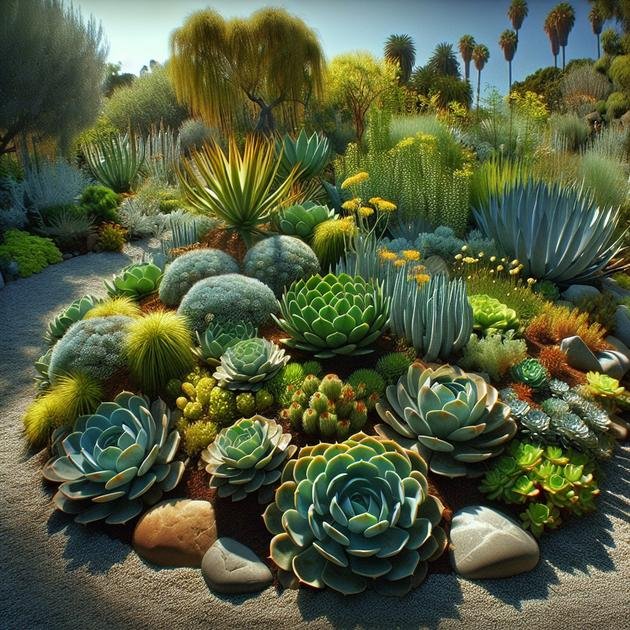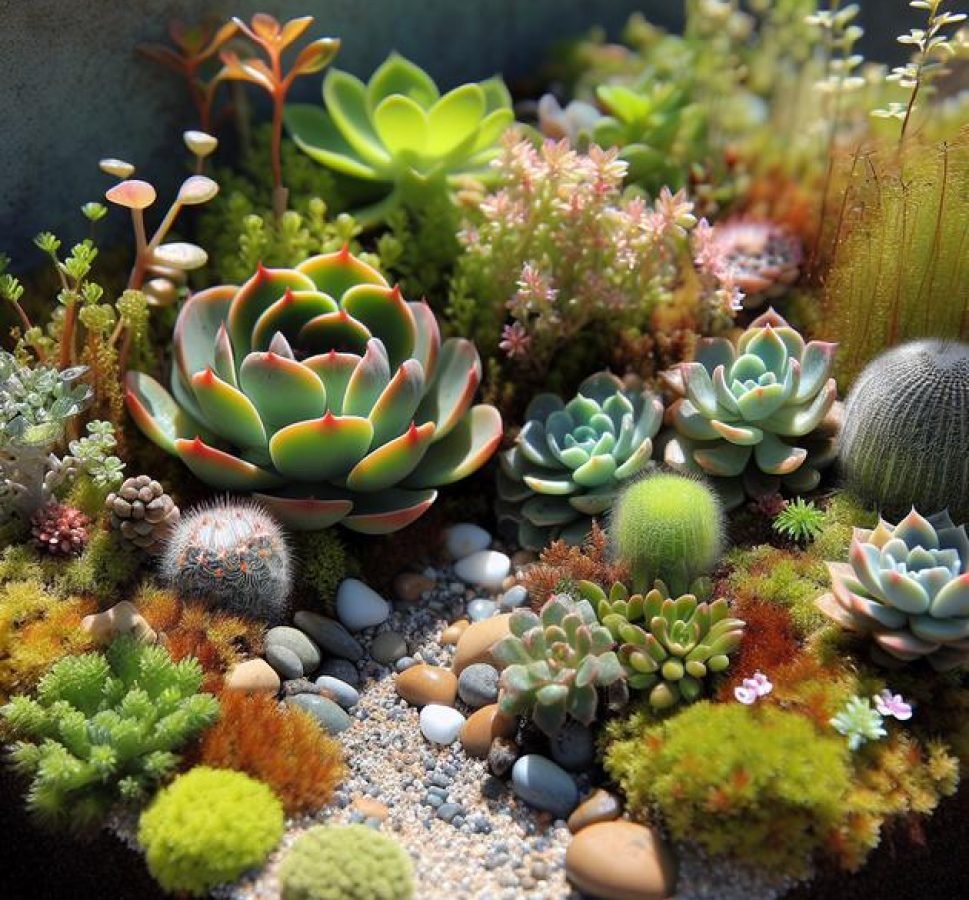Drought resistant gardens use plants and design techniques that minimize water usage by selecting hardy species, improving soil and mulch, applying efficient watering methods, and focusing on native plants to create sustainable, low-maintenance landscapes that thrive in dry conditions.
You might have wondered how some gardens stay lush with little water. Drought resistant gardens offer an appealing solution, mixing beauty with smart water use. Let’s explore how to create one that suits your space and lifestyle.
Understanding drought resistance in plants
Drought resistance in plants refers to their ability to survive and grow in dry, low-water conditions. These plants have adapted over time with special features to conserve water and reduce stress during drought periods. Common adaptations include deep root systems that reach groundwater, thick leaves with waxy coatings to minimize water loss, and the ability to go dormant when water is scarce.
How Plants Adapt to Survive Drought
Deep roots help plants access water far below the soil surface, making them more resilient in dry environments. Some plants also have small or needle-like leaves that reduce surface area and evaporation.
Many drought-resistant plants possess specialized cells that store water, like succulent leaves or stems. Others may have a waxy or hairy leaf surface that blocks sunlight and reduces evaporation.
Benefits of Choosing Drought-Resistant Plants
These plants require less frequent watering, helping you save water and lower water bills. They are also often low-maintenance and less prone to pests and diseases. By incorporating drought-resistant plants into your garden, you create a sustainable and environment-friendly space.
Understanding the unique features of these plants helps in selecting the right species suited for your local climate and soil, ensuring your garden thrives with minimal water use.
Design principles for drought-resistant gardens
Designing a drought-resistant garden requires planning and smart choices to maximize water efficiency and visual appeal. Start by organizing your space to group plants with similar water needs together, known as hydrozoning. This method reduces water waste and makes irrigation more effective.
Choosing Garden Layout and Materials
Opt for permeable materials like gravel or mulch for pathways and beds. Mulch helps retain soil moisture and prevents weeds, further conserving water. Incorporating raised beds can improve drainage and soil quality, making conditions favorable for drought-tolerant plants.
Maximizing Shade and Wind Protection
Planting trees or shrubs strategically can provide natural shade, reducing evaporation from soil and plants. Windbreaks help protect delicate plants from drying winds, which can quickly sap moisture. Use structures like trellises or pergolas to create shaded seating areas that complement the garden design.
Focal Points and Visual Interest
Use varied textures and colors from drought-resistant plants to create interest. Succulents, ornamental grasses, and flowering natives add depth and vibrancy while requiring minimal water. Group plants with contrasting shapes and foliage for a dynamic look, maintaining aesthetic balance with function.
Irrigation Considerations
Incorporate drip irrigation systems to deliver water directly to the roots, minimizing evaporation. Ensure slopes and grading direct water efficiently and avoid pooling. Collect rainwater with barrels or cisterns to supplement watering needs sustainably.
Choosing the right soil and mulch

Choosing the right soil and mulch is crucial for a successful drought-resistant garden. Well-prepared soil improves water retention and provides essential nutrients to plants. Aim for loamy soil mixed with organic matter like compost to boost fertility and structure.
Soil Preparation for Water Efficiency
Adding organic materials helps soil hold moisture longer while improving drainage. Avoid heavy clay soils that retain too much water or sandy soils that drain too quickly. Testing soil pH and adjusting with amendments can create the best environment for drought-tolerant plants.
Types of Mulch for Drought Gardens
Mulch serves several purposes: retaining moisture, suppressing weeds, and regulating soil temperature. Organic mulches like bark chips, straw, or shredded leaves decompose slowly, enriching soil. Inorganic mulches such as gravel and rocks provide long-lasting moisture protection and add texture.
Applying Mulch Effectively
Spread mulch to a depth of 2-4 inches around plants, keeping it a few inches away from stems to prevent rot. Mulching conserves moisture by reducing evaporation and helps protect soil organisms vital for plant health.
Best drought-resistant plants for various climates
Selecting the best drought-resistant plants depends on your climate and garden conditions. Plants that thrive in hot, arid regions may vary greatly from those suited for cooler, Mediterranean climates.
Plants for Hot and Arid Climates
Succulents such as agave and aloe vera store water in their leaves and withstand high temperatures. Cacti are also excellent choices, requiring very little water once established.
Plants for Mediterranean Climates
Lavender, rosemary, and sage are herbs that thrive with minimal water and bring lovely scents and color. Olive trees and certain types of ornamental grasses like feather grass adapt well to dry summers.
Plants for Cooler or Temperate Climates
Plants like Russian sage, yucca, and certain types of sedum perform well even with cooler temperatures and limited water. These plants are hardy and low-maintenance, ideal for gardens facing seasonal droughts.
Native Plants as Ideal Drought-Tolerant Options
Native plants are naturally adapted to your region’s climate and soil. Incorporating them reduces water needs and supports local wildlife. Research native species that flourish in your area for sustainable gardening.
Efficient watering techniques to save water
Efficient watering is essential to maintain a drought-resistant garden while conserving water. One of the best ways to save water is to use a drip irrigation system, which delivers water directly to the plant roots, minimizing evaporation and runoff.
Watering at the Right Time
Water plants early in the morning or late in the evening to reduce water loss from evaporation. Avoid watering during the heat of the day when most water evaporates quickly.
Use Mulch to Retain Moisture
Applying mulch around plants helps keep soil moist and reduces the frequency of watering. Mulch also cools the soil and prevents weeds that compete for moisture.
Rainwater Harvesting
Collect rainwater with barrels or cisterns to supplement garden irrigation. This fresh, natural water supports plant health and reduces dependence on municipal water supplies.
Smart Watering Devices
Consider installing moisture sensors or timers that automate watering schedules based on soil moisture levels. These tools prevent overwatering and ensure plants receive the right amount of water.
Incorporating native plants into your garden

Incorporating native plants into your drought-resistant garden is a smart way to ensure plants thrive with minimal water and maintenance. Native plants are naturally adapted to your local environment, so they require less irrigation and are more resistant to pests and diseases.
Benefits of Using Native Plants
Native plants support local wildlife like bees, butterflies, and birds by providing natural food and habitat. They also help maintain the local ecosystem balance and improve soil health.
Choosing the Right Native Plants
Research native species that suit your garden’s soil, light, and water conditions. Examples include flowering perennials, shrubs, and grasses that flourish in your specific climate zone.
Tips for Planting Natives
Plant native species in clusters to mimic their natural growth pattern, which helps with moisture retention and protection. Combining different plant heights and textures adds visual interest and promotes biodiversity.
Maintaining Native Plant Gardens
Once established, native plants need little watering aside from occasional deep watering during prolonged dry spells. Regularly remove invasive species and dead plant material to keep your garden healthy.
Maintaining your drought-resistant garden year-round
Maintaining a drought-resistant garden year-round involves regular care and smart practices to keep plants healthy and water-efficient. Start by monitoring soil moisture and adjusting watering schedules according to the seasons.
Seasonal Watering Adjustments
During hotter months, plants may need more frequent but deep watering to encourage strong root growth. In cooler or rainy seasons, reduce watering to prevent over-saturation and root rot.
Pruning and Deadheading
Regularly prune your plants to remove dead or damaged branches. Deadheading spent flowers promotes new blooms and maintains garden tidiness, conserving the plant’s energy.
Weed Control
Weeds compete with your plants for water and nutrients. Keep them in check by mulching and manual removal to maintain a healthy garden environment.
Soil Health and Mulching
Replenish mulch layers annually to retain moisture and regulate soil temperature. Adding compost or organic matter boosts soil nutrients, supporting plant growth.
Monitoring for Pests and Diseases
Keep an eye out for signs of pests or diseases common to your plants. Early detection allows for natural or organic treatments that protect your garden without harmful chemicals.
Common mistakes to avoid in drought gardening
One common mistake in drought gardening is overwatering. Even drought-resistant plants need water, but too much can lead to root rot and other issues. Water deeply but infrequently to encourage strong root systems.
Choosing the Wrong Plants
Selecting plants not suited for your climate or soil can cause poor growth and wasted resources. Always research and choose truly drought-tolerant species adapted to your area’s conditions.
Poor Soil Preparation
Ignoring soil health is another error. Compact or nutrient-poor soil can hinder water absorption. Incorporating organic matter improves soil structure and moisture retention.
Failing to Use Mulch
Not applying mulch leads to higher evaporation rates and weed growth. Mulch conserves moisture and keeps soil cooler.
Improper Plant Spacing
Planting too densely can increase competition for water and nutrients. Follow spacing guidelines to ensure plants have enough room to thrive.
Neglecting Maintenance
Skipping tasks like pruning, weeding, and monitoring for pests may reduce plant health. Regular care helps maintain a vigorous, drought-resistant garden.
Wrapping up drought-resistant gardening
Creating and maintaining a drought-resistant garden is both practical and rewarding. By choosing the right plants, preparing your soil well, and using smart watering techniques, you can enjoy a beautiful garden that saves water.
Avoiding common mistakes like overwatering, poor plant selection, and neglect helps your garden thrive even in dry conditions. With regular care and attention, your garden will become a sustainable, low-maintenance space full of life.
Embrace drought-resistant gardening to conserve water, reduce costs, and create an inviting outdoor area that lasts year-round.





